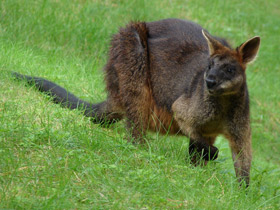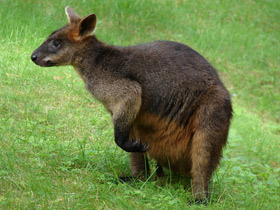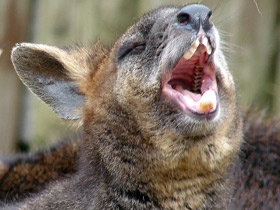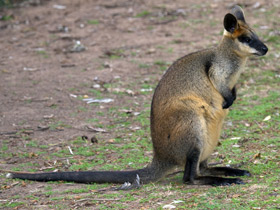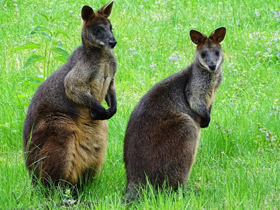The swamp wallaby (Wallabia bicolor), the black wallaby, black-tailed wallaby, fern wallaby, black pademelon, stinker and black stinker
The swamp wallaby (Wallabia bicolor) is a small macropod marsupial of eastern Australia. This wallaby is also commonly known as the black wallaby, with other names including black-tailed wallaby, fern wallaby, black pademelon, stinker (in Queensland), and black stinker (in New South Wales) on account of its characteristic swampy odour.
The swamp wallaby is the only living member of the genus Wallabia.
Etymology
Historic names for the swamp wallaby include Aroe kangaroo and Macropus ualabatus, as well as banggarai in the Dharawal language.
Habitat
Wallabia bicolor is a small macropod marsupial endemic to eastern Australia. It is the only known representative of the genus Wallabia. The species is fairly common, and is not threatened. Wallabia bicolor is common in eastern Queensland, New South Wales and southeastern South Australia. The species has also been introduced to New Zealand and Kawau Island, where it has lived and bred successfully since 1870. Despite its name, the Wallabia bicolor does not live in mudflats, but inhabits densely vegetated wet plains and mangrove swamps, and can also be found in forests.
Appearance and peculiarities
The adult Wallabia bicolor is 75-85 cm long and weighs 15-20 kg. They have a long (about 65 cm), muscular tail and a long, thick coat. Wallabies are large, heavy jumpers, and can move on all four limbs when feeding. At the slightest threat, these kangaroos scurry to the ground, trying to be invisible. If their location is revealed, they scatter immediately, displaying unusual agility and dexterity.
Nutrition
The jumping Wallabia bicolor feeds exclusively on plants, preferring mostly soft and succulent grasses, leaves and grains. However, if necessary, they may eat tree bark, needles and even some species of poisonous plants, which domestic livestock avoid at the drop of a hat.
Social behaviour and reproduction
Wallabia bicolor live in small groups. One of these groups usually owns a 300 square metre plot of land, which, however, is not protected from other animals. Females are able to produce offspring every 8 months, and even more often if the previous offspring dies. This is possible because the female is ready to fertilise while the first embryo is still developing inside her. The fact is that she mates again a few days before giving birth. Thus, in addition to the almost "ready" offspring, she has a fertilised egg in her uterus, which patiently awaits its turn, i.e. the exit of the previous offspring from the pouch. The pregnancy itself lasts between 33 and 38 days. Normally only one kangaroo is born, twins are extremely rare. Both male and female wallabies reach maturity at 15 months of age.
Taxonomy
Several physical and behavioral characteristics make the swamp wallaby different enough from other wallabies that it is placed apart in its own genus, Wallabia. However, genetic evidence (e.g. Dodt et al, 2017) demonstrates that Wallabia is embedded within the large genus Macropus, necessitating reclassification of this species in the future.
Threats
Anthropogenic actions, such as the increase in roads through swamp wallaby habitats, are a threat to their survival. They are frequently seen near the side of roads, leading to a larger number becoming roadkill.
Other sources of threat for the swamp wallaby are their predators, which include dingoes, eagles and wild dogs.

















